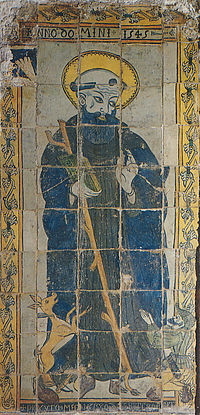Calogerus the Anchorite
You can help expand this article with text translated from the corresponding article in Italian. (March 2023) Click [show] for important translation instructions.
|
This article needs additional citations for verification. (July 2022) |
Calogeros the Anchorite (Greek: Καλόγερος ὁ Αναχωρητής, translit. Kalogeros ho Anakhorētēs, Kalogeros o Anakhoritis, Latin: Calogerus or Calocerus, Sicilian: Calòjiru and Caloriu, Italian: Calogero, also known as Calogerus the Hermit and Calogerus of Sicily, Chalcedon c. 466 – 18 June, 561, Monte Kronio) was a hermetical monk, venerated as a saint by the Catholic and Orthodox churches, and the patron of many places in Sicily.
Veneration[edit]
Calogerus | |
|---|---|
 Icon of Saint Calogerus from the grotto above Mount Kronio, dated 1545 | |
| Calogerus the Anchorite, Calogerus the Hermit, Calogerus of Sicily, San Calogero | |
| Born | c. 466 Chalcedonia |
| Residence | Monte Kronio |
| Died | 561 Sciacca |
| Venerated in | Roman Catholic Church, Eastern Orthodox Church |
| Major shrine | Sanctuary of San Calogero, Agrigento, Sicily |
| Feast | 18 June |
| Attributes | Hermit, Basilian abbot |
| Patronage | Naro, Campofranco, Petralia Sottana, and San Salvatore di Fitali in Sicily |
Tradition or genre | Hermetical, Basilian |
Calogerus is commemorated by the Orthodox Church on June 18, together with the bishop Gregorius and the deacon Demetrius. The three saints are noted as opponents of Arianism who fled from Africa to Sicily to escape persecution. They were active in the area of Fragalata, near Messina.[1] Calogerus is commemorated on the same day in the Catholic Church. Calogerus is also held to have worked as a missionary on Lipari in the Aeolian Islands, before retiring to live as a hermit on Monte Kronio, which is now sometimes called in Sicilian: Monte San Caluòru (Italian: Monte San Calogero) in his honor, as is another mountain near Palermo.
Saint Calogerus is venerated at Agrigento more than Saint Gerland, who is the patron of Agrigento. Other centres in which Saint Calogero is particularly venerated are Porto Empedocle, Naro, Sciacca, Frazzanó, San Salvatore di Fitalia, Cesaró, Petralia Sottana and Campofranco. In iconography, he is usually identifiable as a bearded hermit with olive complexion wearing eastern (Syriac) hooded vestments.
See also[edit]
References[edit]
- ^ "Τῇ αὐτῇ μέρᾳ, μνήμη τῶν ὁσίων πατέρων μῶν Γρηγορίου, Δημητρίου καί Καλογήρου, τῶν ᾿Αναχωρητῶν" ["On this day, the commemoration of the Sainted Fathers Gregory, Demetrius, and Calogerus the Anchorites]. Apostoliki Diakonia: Eorlogio (in Greek). Apostoliki Diakonia (Apostolic Auxiliary) of the Holy Synod of the Church of Greece. Retrieved 12 April 2017.
῾Ο ᾿Επίσκοπος Γρηγόριος, ὁ Διάκονος Δημήτριος καί ὁ ᾿Ερημίτης Καλόγηρος ἔζησαν περί τά τέλη τοῦ 5ου αἰῶνος μ.Χ. ᾿Εξεδιώχθησαν ἀπό τή Βόρειο ᾿Αφρική ἀπό τούς αἱρετικούς ᾿Αρειανούς καί κατέφυγαν στή Μεσίνα τῆς ᾿Ιταλίας, κοντά στήν περιοχή Φραγκάλατα, ὅπου ἐκήρυσσαν τό Εὐαγγέλιο καί ἐστερέωναν τούς Χριστιανούς στήν πίστη τοῦ Χριστοῦ. ᾿Εκοιμήθησαν μέ εἰρήνη ("The bishop Gregory, the deacon Demetrius, and the hermit Calogerus lived around the end of the 5th century A.D. They were exiled from North Africa by the Arian heretics and fled to Messina in Italy, near the region of Fragalata, where they proclaimed the Gospel and instructed the Christians in the faith of Christ. May they rest in peace.")
